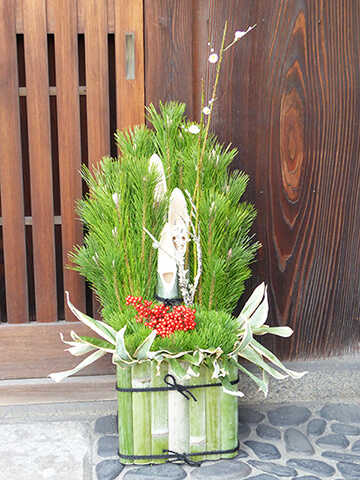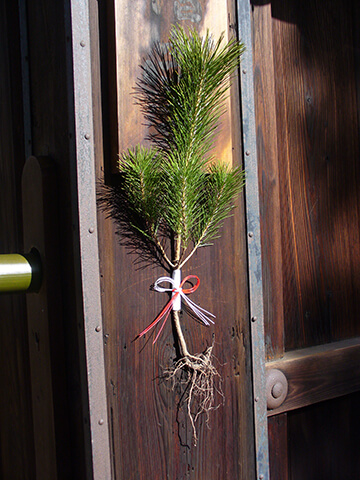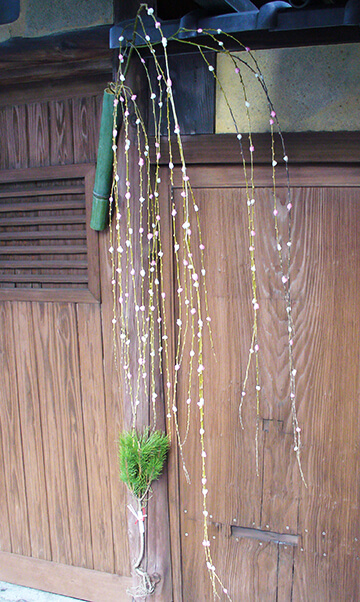
As the New Year begins, the streets of Kyoto are filled with a clean and festive atmosphere as New Year's good luck charms are displayed here and there.The Three Sacred Treasures of New Year's DecorationsSpeaking of which.Shimenawa, Kadomatsu, KagamimochiI guess."
Kadomatsu, among others,Yorishiro for welcoming the god of the yearThe most common type of decoration is a green bamboo pole with a pine tree or plum tree around it. The most common type of decoration is a green bamboo tree at the center, surrounded by pine trees and plum trees, representing "heaven, earth, and people.

Kadomatsu (pine, bamboo and plum tree)
It was probably born out of people's wish to spend a better and healthier year by arranging lucky charms with more powerful spiritual power at the beginning of the New Year. It is also said that the custom of decorating the kadomatsu, a pine tree brought back from the mountains to be used as a guardian deity, was the origin of ikebana, the art of flower arrangement.
By the way, walking around Kyoto on New Year's Day, especially in temples, shrines, flower streets, and old houses, you can see Kyoto's unique"Roots pulled pine."It is common to see kadomatsu (gate pine) decorated called "Kadomatsu.

dwarf Japanese white pine (Pinus parviflora)
As the name implies, it is a young pine tree with its roots still attached, with Japanese paper wrapped around the middle of the branch and a mizuhiki hanging from it. According to the information we were given during the interview, the roots are left attached to the pine tree.. so that we can stay grounded."And,"So that we can continue to grow."He said that this was the meaning of the word.
Among the typical New Year's lucky charms,rope used to cordon off consecrated areas or as a talisman against evilwas introduced in the last issue, so here is the remaining one,mirror-shaped mochi, usu. a pair of mochi pieces, each of which is decorated with a red bean pasteI interviewed a person about the "Mochi-hikagami," which is said to have been called "Mochi-hikagami" in ancient times, as the mirror and the rice cake were opposite each other.
In "The Tale of Genji", "Hatsune", a rice cake mirror appears in a New Year's event to celebrate longevity, but in those days, people did not eat the rice cake after the event,It was a lucky charm to see and pray for peace.The mirror has been treated as a ritual tool to reflect the true image of things of all kinds, including demons. Since ancient times, mirrors have also been treated as ritual implements that reflect the true nature of things of all kinds, including demons, and as treasures that symbolize authority,The round shape has spiritual power.In Kyoto, round rice cakes have also been used for ozoni (rice cake stew). In Kyoto, round rice cakes have also been eaten for ozoni (rice stew), out of concern for "not having any corners".
Other lucky charms related to rice cakes are,"Mochi Hana."The rice cake is said to bring good luck. It is said to bring good luck, and is made of white or red-dyed rice cakes that are rolled into small balls and attached to the branches of willow trees or other plants. Although the history of this new good-luck charm in Kyoto is short, it seems to have been born out of the Kyoto people's love for the elegant and refined way of life and their desire to bring in spring as soon as possible. When you walk around the city during New Year's, you will see them decorating tea stores and storefronts in the Hanamachi district, giving the appearance of red and white flowers in full bloom, adding color to a season when flowers are scarce.

Mochi flowers seen in town
Thus, in Kyoto, the New Year is celebrated by decorating with lucky charms,An important custom that has continued since the Heian period (794-1185) to obtain peace of mind by receiving blessings to ward off bad luck.The older people I interviewed said that they are
However, recently, there are more and more households that do not use New Year's decorations, but I believe that the New Year's decorations, which have been passed down to the present day, have been filled with people's wishes and prayers since ancient times, and have been passed down to the present day with great ingenuity.hidden powerIt does not seem that there are to start the New Year with a good feeling,New Year's decorations, and also catch sight of them as you walk around the city, to give you new power for the year ahead!Thing.
Tradition that exists everywhere in the city of Kyoto. It is not just a picture, it is secretly alive in this modern age and continues to coexist with people. The two of Office TO, who previously wrote a series of articles "Kyoto's Demon World Exploration" in the monthly magazine Leaf, explore the mysterious "different" world of Kyoto, which was created over 1200 years. I will unravel the story while actually visiting the place. .
 News
News Feature article
Feature article Featured event
Featured event